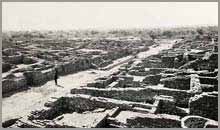Recodable Objects
 By re-using photographs which had been published in The Illustrated London News before, including cutting out and juxtaposing photographs of similar looking objects, found at Ur, Susa, Al Ubaid, Harappa and Mohenjodaro, Gadd and Smith fashioned two photographic displays (1924, p. 615 & 616), which were aimed to offer the visual confirmation of what they believed, viz., the presence of an “early Indian and Babylonian kinship” (ibid, p. 616). But it is only by fixing a truth value, that of equivalency (see Kopytoff, 1986 for definition), on dissimilar photographs, of different artefacts, from dissimilar sites and geographical areas, could they impress upon the readers the plausibility of their hypothesis. The displays highlight the paradox that is often inherent in our engagements with photographs. Guided by our faith in the similitude between an image and its referent, we endow photographs with values of an immutable record. At the same time, by placing photographs in certain relationships we initiate our own interpretive processes, and inevitably attribute to them the kind of meanings we imagine they should give.
By re-using photographs which had been published in The Illustrated London News before, including cutting out and juxtaposing photographs of similar looking objects, found at Ur, Susa, Al Ubaid, Harappa and Mohenjodaro, Gadd and Smith fashioned two photographic displays (1924, p. 615 & 616), which were aimed to offer the visual confirmation of what they believed, viz., the presence of an “early Indian and Babylonian kinship” (ibid, p. 616). But it is only by fixing a truth value, that of equivalency (see Kopytoff, 1986 for definition), on dissimilar photographs, of different artefacts, from dissimilar sites and geographical areas, could they impress upon the readers the plausibility of their hypothesis. The displays highlight the paradox that is often inherent in our engagements with photographs. Guided by our faith in the similitude between an image and its referent, we endow photographs with values of an immutable record. At the same time, by placing photographs in certain relationships we initiate our own interpretive processes, and inevitably attribute to them the kind of meanings we imagine they should give.
Within the context of Social Anthropology it has been suggested that “the persistent–and perhaps utopian–belief that the affective appeal of the visual can be brought in line with scientific ideals of objective observation”, speaks of the “nervousness”, which has surrounded the use of “visual technologies of photography and film” during much of the twentieth century (Poole 2005, p. 168). With respect to Archaeology, however, the utopia of objectivity has been well fed through rules on archaeological photography (e.g. Cookson, ibid). In stark contrast to photographing people, it has been, after all, relatively easy to remove the “intrusion of humanising, cultural details” (Edwards 2001, P. 144) from the photography of archaeological sites, landscapes and artefacts.
Yet, it is precisely the humanising and cultural ‘intrusions’, which allow the unearthed archaeological objects to be endowed with potentials of evidence (see also Guha 2005). To ‘see’ Mohenjodaro, Marshall reflected on something he had personal experience of, i.e. the ‘bleak’ landscape of the mill towns of north England. He wrote in the official report that “anyone walking for the first time” through “the wide expanse of bare red brick structures” which is “devoid of any semblance of ornament, and bearing in the feature the mark of stark utilitarianism might fancy himself surrounded by the ruins of some present day working town in Lancashire” (1931, p. 15). Fitting this rumination is the photograph of one of his Indian superintendents, in the garb of an ‘English man’ walking on this ‘prehistoric’ town’s “first” street (Figure 28). The photograph remained unpublished, and, perhaps, because it so eloquently evoked Marshall’s reflections––one of the many through which he successfully mediated upon the historical presence he assured had been only ‘uncovered’.
The archaeological making of the Indus Civilisation until now has shown rather clearly that the archaeological record is neither self-revelatory, nor fixed in its definitions. Since in the case of Harappa and Mohenjodaro, the excavated material and its supposedly representational photographs have both proved to be infinitely recodable. Although, the fundamentalism of positivist thinking, of Marshall and Wheeler’s days, strives to eliminate, for example, through photography for archaeological purposes, our traces of encounters with the objects we excavate, interpret, evaluate, and classify, it is these encounters, such as Marshall’s, which often allow us to reflect upon, and interpret, the archaeological record. By participating within the disciplinary praxis, photographs have remained integral to knowledge formation on the archaeological. However, as linking objects of the past and present, with endless ‘unlocked’ histories within their surfaces, photographs also show us precisely why archaeological knowledge is never the sum of seeing and knowing.
